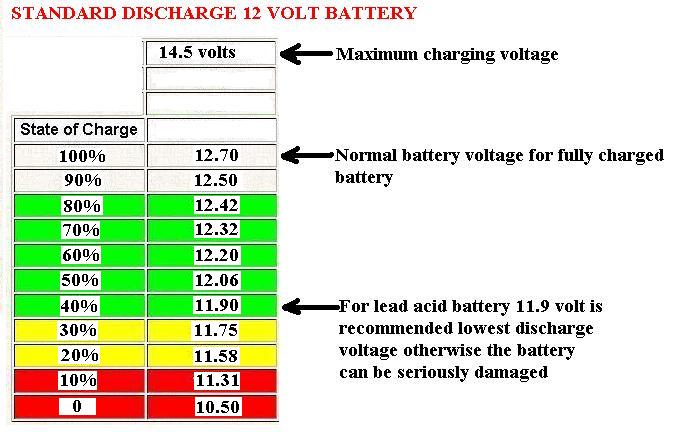locoboy
|
| posted on 15/9/16 at 07:16 PM |

|
|
Is my maths correct watts, volts, Amps!
I have a camper van and my leisure battery is 110Ah.
My cool box is 47W (DC 12v)
So 47/12 =3.91
110Ah/3.91A =28hours
So in theory it should last me 28 hours.
Now i have been advised not to discharge the battery below 11.5 volts to avoid any damage etc.
so am I right in thinking that in theory I could run the cool box for the calculated 28 hours and it wouldn't discharge to below my safe limit
of 11.5 volts?
Cheers
Colin
ATB
Locoboy
|
|
|
|
|
ReMan
|
| posted on 15/9/16 at 07:33 PM |

|
|
Yes your maths is correct
But that would theoretically be till flat
But also theoretically the cool box cooling 24-7 which it wouldn't need to I gas like fridge
So regardless of the voltage it took it down to (too much science f me)' you woul not want to max it out!
www.plusnine.co.uk
|
|
|
gremlin1234
|
| posted on 15/9/16 at 08:26 PM |

|
|
quote:
so am I right in thinking that in theory I could run the cool box for the calculated 28 hours and it wouldn't discharge to below my safe
limit of 11.5 volts?
although the maths is right, the battery would be too low after about 20 hours, you would be much better with a
thermostat, and also load it with a little bit of frozen food.
also good that you are using leisure batteries, they are far better for this than standard car batteries
|
|
|
BenB
|
| posted on 15/9/16 at 08:30 PM |

|
|
Voltage will sag as the battery flattens and the wattage is only correct at a nominal 12v.
Anyway, simple rule is don't run a leisure battery down too low. 11.9v is about 40% and is the minimum, some people only go to 50%. So
you'll only get 60% of your 110A at maximum (unless you like buying batteries).
11.9v is an unloaded voltage IE without any drain on the battery.
|
|
|
britishtrident
|
| posted on 15/9/16 at 08:41 PM |

|
|
I wouldn't advise planning take it below 11.9v. Everytime a battery is discharged and recharged it is damaged and the amp hour capacity is
reduced. Below 40 pecent is normally considered the level at which serious damage occurs even in deep cycle batteries.
Also keep in mind as a rough and ready guide if you discharge a a battery its best recharged at the discharge amps/5 or at a rate that will recharge
it in 24 hours which ever is the shortest.
[Edited on 15/9/16 by britishtrident]
[I] “ What use our work, Bennet, if we cannot care for those we love? .”
― From BBC TV/Amazon's Ripper Street.
[/I]
|
|
|
locoboy
|
| posted on 15/9/16 at 08:44 PM |

|
|
Ben,
This 60% you mention does that mean that I only really have 60% of the 110 to use, = 66Ah = 18 hours of runtime?
ATB
Locoboy
|
|
|
britishtrident
|
| posted on 15/9/16 at 09:00 PM |

|
|
Keep in mind a battery starts out with rated AH rating but in service this falls from day one --- the same applies to the CCA rating for starting
batteries.

[I] “ What use our work, Bennet, if we cannot care for those we love? .”
― From BBC TV/Amazon's Ripper Street.
[/I]
|
|
|
on_eighty_runner
|
| posted on 15/9/16 at 11:01 PM |

|
|
If the cooler has a temperature stat. It will consume the 47 watts only whilst working.
If it gets down to its set point it stops operating. This should happen at night.
The aH rating is based on a load to flatten the battery in 8 to 10 hours.
Drawing a high power reduces the effective ah rating
Decreasing the power will increase the effective ah rating.
24 hours should be achievable unless very warm or regularly opened.
|
|
|
DJT
|
| posted on 16/9/16 at 11:57 AM |

|
|
From my experience they run less efficiently when the battery is not on charge from the alternator, e.g. 12.8v vs 14.2v. The fan runs slower for
sure, but I'm not sure how less efficient the Peltier semiconductor is. Also, they keep cool things cool, but do not have the power to
signifanctly cool from warm.
http://tigeravonbuilddiary.blogspot.com/
|
|
|













